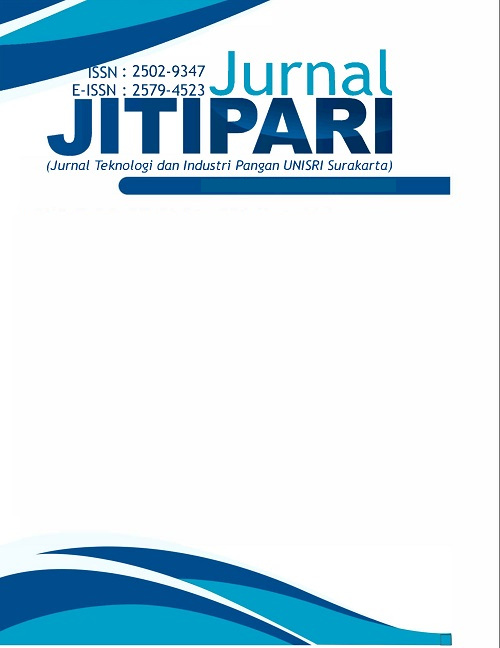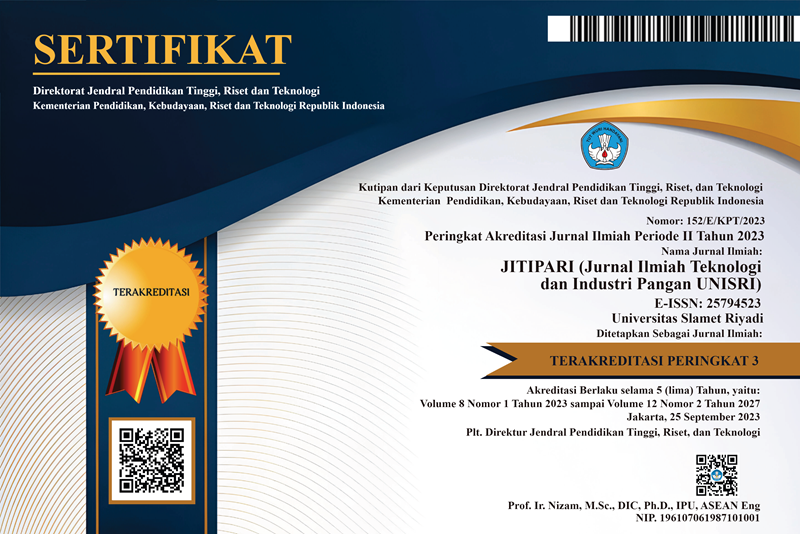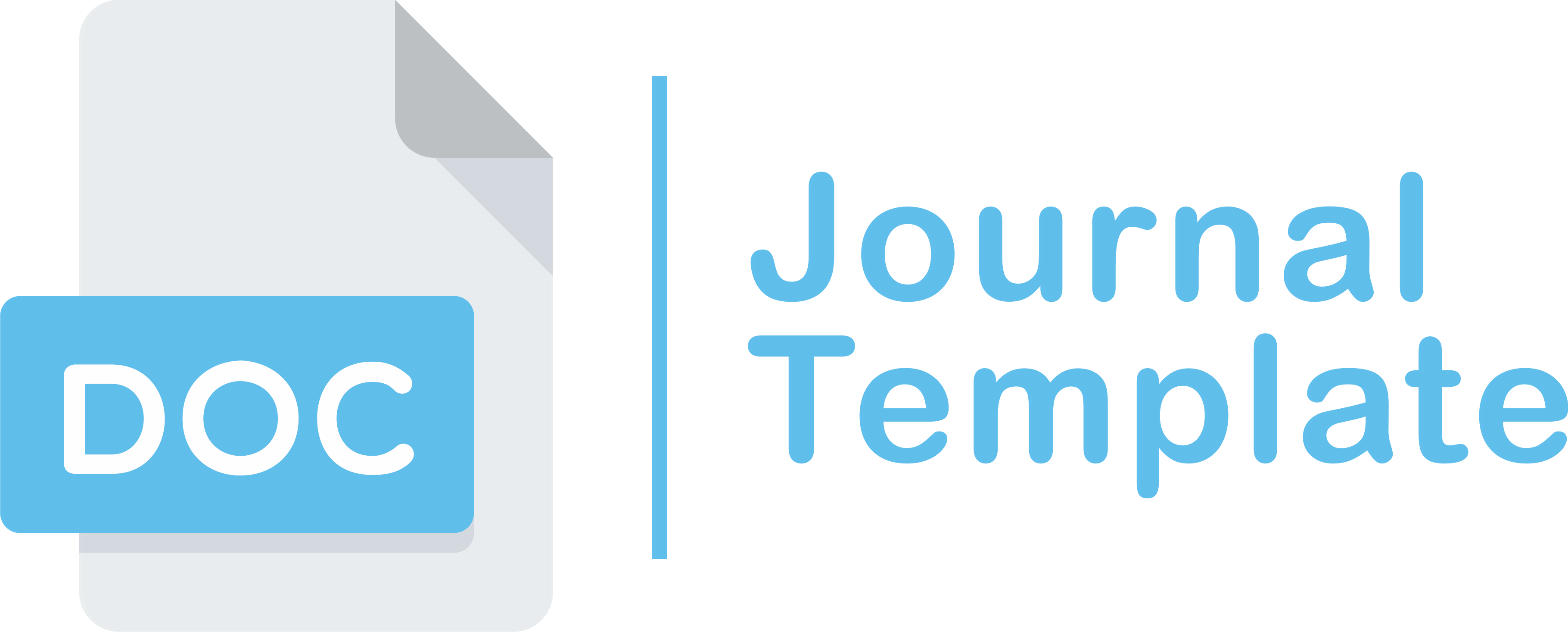Phytochemicals, nutritional, anti-nutritional and bioactivity of Dioscorea pentaphylla L. tuber : A review
Fitokimia, Nutrisi, Anti Nutrisi dan Bioaktivitas Umbi Tomboreso (Dioscorea pentaphylla L.): Kajian Pustaka
DOI:
https://doi.org/10.33061/jitipari.v10i1.10970Abstract
Dioscorea pentaphylla L. tubers, locally known as tomboreso tubers by Indonesian people, grow wild in forests in various parts of Indonesia but are not well-underutilized. This article aims to comprehensively review the phytochemistry, nutritional, anti-nutritional, and bioactivity of tomboreso tubers. The method used is a literature study with a database of online articles downloaded from Google Scholar related to the topic discussed. Various earlier studies reported that tomboreso tubers are rich in phytochemical compounds, such as alkaloids, flavonoids, polyphenols, terpenoids, tannins, glycosides, and saponins. Tomboreso tubers are also rich in complete nutritional content, such as protein content (1.69-9.20%), fat (0.14-6.24%), fiber (1.28-7.24%), starch (3.71-61.26%), minerals, amino acids, and fatty acids. Furthermore, tomboreso tubers also contain anti-nutritional compounds that are less beneficial to health, such as tannins, oxalates, hydrogen cyanide, phenols, flavonoids, phytates, a-amylase inhibitors, and trypsin inhibitors. Tomboreso tubers have been shown to have various biological activities, such as anti-bacterial, anti-mutagenic, and antioxidant, from various earlier studies. To make tomboreso tubers safe to eat and an alternative food source with low anti-nutritional content, further research must be done on their exploration, utilization, and further processing to reduce anti-nutritional compounds.
References
Adnyana, P. E. S. (2021). Empirisme penggunaan tumbuhan pada pengobatan tradisional Bali: Lontar Taru Pramana dalam konstruksi filsafat ilmu. Sanjiwani: Jurnal Filsafat, 12(1), 64–79. https://doi.org/10.25078/sjf.v12i1.2059
Angely, D. R., Nursabrina, A. B., Nikmah, E. S., Rachim, S. D., Marsely, B., Utami, S., & Khotimperwati, L. (2024). Keanekaragaman sumber daya genetik lokal umbi- umbian di Kecamatan Mijen, Kota Semarang, Jawa Tengah. Jurnal Ilmu Lingkungan, 22(1), 11–19. https://doi.org/10.14710/jil.22.1.11-19
Arya, P., Munshi, M., & Kumar, P. (2023). Diosgenin: Chemistry, extraction, quantification and health benefits. Food Chemistry Advances, 2, 100170. https://doi.org/10.1016/j.focha.2022.100170
Chadikun, P., Sakya, A. T., Cahyani, V. R., & Budiastuti, M. T. S. (2020). Physicochemical Characterization of Dioscorea spp. In Manokwari Regency, West Papua. Advances in Engineering Research, 194, 26-29.
Cong, S., Tong, Q., Peng, Q., Shen, T., Zhu, X., Xu, Y., & Qi, S. (2020). In vitro anti-bacterial activity of diosgenin on Porphyromonas gingivalis and Prevotella intermedia. Molecular Medicine Reports, 22(6), 5392–5398. https://doi.org/10.3892/mmr.2020.11620
Cressey, P., & Reeve, J. (2019). Metabolism of cyanogenic glycosides: A review. Food and Chemical Toxicology, 125, 225–232. https://doi.org/10.1016/j.fct.2019.01.002
do Nascimento, W. F., Siqueira, M. V. B. M., da Silva, E. F., & Veasey, E. A. (2021). Cultivation and utilization of diosgenin-contained Dioscorea species. In H. M. Ekiert, K. G. Ramawat, & J. Arora (Eds.), Medicinal Plants: Domestication, Biotechnology and Regional Importance. Springer Cham. https://doi.org/10.1007/978-3-030-74779-4_11
Doss, A., Tresina, P. S., & Mohan, V. R. (2019). Amino acid composition of wild yam (Dioscorea spp.). Food Research, 3(5), 617–621. https://doi.org/10.26656/fr.2017.3(5).119
Fauziah, & Mas’udah, S. (2015). Explorations diversity of Dioscorea spp. varieties from Pasuruan, East Java: Inventory and characterization. Agrivita, 37(3), 193–203. https://doi.org/10.17503/Agrivita-2015-37-3-p193-203
Hang, D. T., Tra, T. T. T., Tuan, L. M., & Savage, G. P. (2017). Effect of Processing on the oxalate and calcium concentrations of two local dishes, Cơm Hến and Canh Chua Bạc Hà, prepared from Taro Stems. Food and Nutrition Sciences, 8, 624–632. https://doi.org/10.4236/fns.2017.86044
Huynh, N. K., Nguyen, D. H. M., & Nguyen, H. V. H. (2022). Effects of processing on oxalate contents in plant foods: A review. Journal of Food Composition and Analysis, 112, 104685. https://doi.org/10.1016/j.jfca.2022.104685
Ifeabunike, O. B., Nwaedozie, J. M., & Aghanwa, C. I. (2017). Proximate analysis, hydrogen cyanide and some essential mineral content of sweet cassava variety (Manihot utilisima) and bitter cassava variety (Manihot palmata) cultivated in Kachia local government area of Kaduna State, Nigeria. International Journal of Biochemistry Research & Review, 19(1), 1-12.
Jumari, & Suedy, S. W. A. (2017). The diversity of Dioscorea spp. In Central Java Indonesia: Local utilization and conservation. Advanced Science Letters, 23(7), 6441–6443. https://doi.org/10.1166/asl.2017.9647
Kamaruddin, Z. H., Sapuan, S. M., Mohamed Yusoff, M. Z., & Jumaidin, R. (2020). Rapid detection and identification of dioscorine compounds in Dioscorea hispida tuber plants by LC-ESI-MS. BioResources, 15(3), 5999–6011. https://doi.org/10.15376/biores.8.3.5999-6011
Kuliahsari, D. E., Sari, I. N. I., & Estiasih, T. (2021). Cyanide detoxification methods in food: A review. IOP Conference Series: Earth and Environmental Science, 733, 012099. https://doi.org/10.1088/1755-1315/733/1/012099
Kumar, S., Das, G., Shin, H. S., & Patra, J. K. (2017a). Dioscorea spp. (A wild edible tuber): A study on its ethnopharmacological potential and traditional use by the local people of similipal biosphere reserve, India. Frontiers in Pharmacology, 8, 52. https://doi.org/10.3389/fphar.2017.00052
Kumar, S., Mahanti, P., Singh, N. R., Rath, S. K., Jena, P. K., & Patra, J. K. (2017b). Antioxidant activity, antibacterial potential and characterization of active fraction of Dioscorea pentaphylla L. tuber extract collected from Similipal Biosphere Reserve, Odisha, India. Brazilian Journal of Pharmaceutical Sciences, 53(4), 1–10. https://doi.org/10.1590/s2175-97902017000417006
Maneenoon, K., Sirirugsa, P., & Sridith, K. (2008). Ethnobotany of Dioscorea L. (Dioscoreaceae), a major food plant of the Sakai Tribe at Banthad Range, Peninsular Thailand. Ethnobotany Research and Applications, 6(December 2008), 385–393. https://doi.org/10.17348/era.6.0.385-394
Maqfiroh, S., Jumari, & Murningsih. (2018a). Cluster analysis of Dioscorea spp. based on amilum and tuber morphology. Journal of Physics: Conference Series, 1025, 012051. https://doi.org/10.1088/1742-6596/1025/1/012051
Maqfiroh, S., Jumari, & Murningsih. (2018b). Clustering of Dioscorea spp. from Semarang district and Boyolali-Indonesia based on characterization starch type and tuber morphology. Journal of Physics: Conference Series, 1025, 012056. https://doi.org/10.1088/1742-6596/1025/1/012056
Mohan, V. R., & Kalidass, C. (2010). Nutritional and antinutritional evaluation of some unconventional wild edible plants. Tropical and Subtropical Agroecosystems, 12, 495–506.
Mosayyebi, B., Imani, M., Mohammadi, L., Akbarzadeh, A., Zarghami, N., Edalati, M., Alizadeh, E., & Rahmati, M. (2020). An update on the toxicity of cyanogenic glycosides bioactive compounds: Possible clinical application in targeted cancer therapy. Materials Chemistry and Physics, 246, 122841. https://doi.org/10.1016/j.matchemphys.2020.122841
Mutha, R. E., Tatiya, A. U., & Surana, S. J. (2021). Flavonoids as natural phenolic compounds and their role in therapeutics: an overview. Future Journal of Pharmaceutical Sciences, 7, 25. https://doi.org/10.1186/s43094-020-00161-8
Naisali, H., Utoro, P. A. R., & Witoyo, J. E. (2023a). Review keragaman dan metode pengolahan umbi-umbian lokal Nusa Tenggara Timur. Jurnal Pangan dan Gizi, 13(2), 1–17. https://doi.org/10.26714/jpg.13.2.2023.1-17
Naisali, H., Witoyo, J. E., & Utoro, P. A. R. (2023b). Local Legumes from Dry Land of East Nusa Tenggara: diversity, nutritional composition, and their use in society – A literature study. JITIPARI (Jurnal Ilmiah Teknologi dan Industri Pangan UNISRI), 8(2), 155–166. https://doi.org/10.33061/jitipari.v8i2.9054
Nan, S, Wang, P. T., Zhu, Q. L., Sun, J. Y., Zhang, H. Y., Liu, X. Y., Cao,T.X, Chen, X., Huang, Y.J. & Zhou, Q. H. (2020). Comprehensive characterization of yam tuber nutrition and medicinal quality of Dioscorea opposita and D. alata from different geographic groups in China. Journal of Integrative Agriculture, 19(11), 2839-2848. https://doi.org/10.1016/S2095-3119(20)63270-1
Nazir, R., Pandey, D. K., Pandey, B., Kumar, V., Dwivedi, P., Khampariya, A., Dey, A., & Malik, T. (2021). Optimization of diosgenin extraction from Dioscorea deltoidea tubers using response surface methodology and artificial neural network modelling. PLoS ONE, 16, e0253617. https://doi.org/10.1371/journal.pone.0253617
Nurilmala, F., & Mardiana, D. (2019). Nutrients and anti-nutrients content analysis of Bogor taro mutant clone (Colocasia esculenta). IOP Conference Series: Earth and Environmental Science, 334, 012070. https://doi.org/10.1088/1755-1315/334/1/012070
Obidiegwu, J. E., Lyons, J. B., & Chilaka, C. A. (2020). The Dioscorea Genus (Yam)—An Appraisal of Nutritional and Therapeutic Potentials. Foods, 9, 1304. https://doi.org/10.3390/foods9091304
Padhan, B., Biswas, M., Dhal, N. K., & Panda, D. (2018). Evaluation of mineral bioavailability and heavy metal content in indigenous food plant wild yams (Dioscorea spp.) from Koraput, India. Journal of Food Science and Technology, 55(11), 4681–4686. https://doi.org/10.1007/s13197-018-3388-3
Padhan, B., Biswas, M., & Panda, D. (2020a). Nutritional, anti-nutritional and physico-functional properties of wild edible yam (Dioscorea spp.) tubers from Koraput, India. Food Bioscience, 100527. https://doi.org/10.1016/j.fbio.2020.100527
Padhan, B., Nayak, J. K., & Panda, D. (2020b). Natural antioxidant potential of selected underutilized wild yams (Dioscorea spp.) for health benefit. Journal of Food Science and Technology, 57(6), 2370–2376. https://doi.org/10.1007/s13197-020-04470-x
Padhan, B., & Panda, D. (2020). Potential of Neglected and underutilized yams (Dioscorea spp.) for improving nutritional security and health benefits. Frontiers in Pharmacology, 11, 496. https://doi.org/10.3389/fphar.2020.00496
Panda, D., Padhan, B., Nanda, M., Sahu, A., & Nayak, J. K. (2023). Blending neglected and underutilised wild yam tubers from forest to functional food. Food and Humanity, 1, 1338–1344. https://doi.org/10.1016/j.foohum.2023.09.030
Paulpriya, K., & Mohan, V. R. (2013). In vitro antioxidant activity of methanol extract of Dioscorea pentaphylla L. var pentaphylla tuber. International Journal of Universal Pharmacy and Bio Sciences, 2(2), 161–173.
Poonsri, T., Jafarzadeh, S., Ariffin, F., & Zainul Abidin, S. (2019). Improving nutrition, physicochemical and antioxidant properties of rice noodles with fiber and protein-rich fractions derived from cassava leaves. Journal of Food and Nutrition Research, 7(4), 325–332. https://doi.org/10.12691/jfnr-7-4-10
Prakash, G., Hosetti, B. B., & Dhananjaya, B. L. (2014). Antimutagenic effect of Dioscorea Pentaphylla on genotoxic effect induced by methyl methanesulfonate in the drosophila wing spot test. Toxicology International, 21(3), 258–263. https://doi.org/10.4103/0971-6580.155341
Purnomo, Malikah, & Maryani. (2018). Diversity and phenetic analysis of tomboreso (Dioscorea pentaphylla L.) in Yogyakarta based on morphological and leaf anatomical characters. AIP Conference Proceedings, 2002, 020049–1–020049–9. https://doi.org/10.1063/1.5050145
Rozali, Z. F., Zulmalisa, Z., Sulaiman, I., Lubis, Y. M., Noviasari, S., Eriani, K., & Asrizal, C. W. (2021). Decreased of calcium oxalate levels in the purple taro flour (Colocasia esculenta) from Aceh Province, Indonesia using three immersion methods. IOP Conference Series: Earth and Environmental Science, 711, 012022. https://doi.org/10.1088/1755-1315/711/1/012022
Saleha, S., Saidi, N., Rasnovi, S., & Iqbalsyah, T. M. (2018). Nutritional composition of Dioscorea hispida from different locations around Leuser ecosystem area. Jurnal Natural, 18(1), 1-6. https://doi.org/10.24815/jn.v18i1.8504
Salgado, N., Silva, M. A., Figueira, M. E., Costa, H. S., & Albuquerque, T. G. (2023). Oxalate in foods: extraction conditions, analytical methods, occurrence, and health implications. Foods, 12, 3201. https://doi.org/10.3390/foods12173201
Shajeela, P.S., Mohan, V. R., Jesudas, L. L., & Soris, P. T. (2011). Nutritional and antinutritional evaluation of wild yam (Dioscorea spp.). Tropical and Subtropical Agroecosystems, 14, 723–730.
Shajeela, Ponnumani Sundaradhas, Tresina, P. S., & Mohan, V. R. (2013). Fatty acid composition of wild yam (Dioscorea spp.). Tropical and Subtropical Agroecosystems, 16, 35–38.
Shanthakumari, S., Mohan, V. R., & Britto, J. de. (2008). Nutritional evaluation and elimination of toxic principles in wild yam (Dioscorea spp.). Tropical and Subtropical Agroecosystems, 8(3), 319–325.
Shen, L., Xu, J., Luo, L., Hu, H., Meng, X., Li, X., & Chen, S. (2018). Predicting the potential global distribution of diosgenin-contained Dioscorea species. Chinese Medicine, 13, 58. https://doi.org/10.1186/s13020-018-0215-8
Silalahi, M. (2022). Dioscorea esculenta (Lour.) Burkill: Uses and bioactivity. International Journal of Biological and Pharmaceutical Sciences Archive, 3(2), 20–25. https://doi.org/10.53771/ijbpsa.2022.3.2.0037
Vivek, S., & Prakash, S. (2018). Analysis of nutrient composition and phytochemicals of wild yams Dioscorea pentaphylla L. and Dioscorea oppositifolia Griseb. Brazilian Journal of Biological Sciences, 5(10), 427–432. https://doi.org/10.21472/bjbs.051019
Wang, Z., Zhao, S., Tao, S., Hou, G., Zhao, F., Tan, S., & Meng, Q. (2023). Dioscorea spp.: bioactive compounds and potential for the treatment of inflammatory and metabolic diseases. Molecules, 28, 2878. https://doi.org/10.3390/molecules28062878
Wuryantoro, W., Wardhani, R. M., Puspitawati, I. R., Adinurani, P. G., & Yamin, B. M. (2021). Exploration and characterization of “uwi” plant (Dioscorea sp.) in East Java Uplands, Indonesia. E3S Web of Conferences, 226, 1–8. https://doi.org/10.1051/e3sconf/202122600049
Yani, A., & Rawiniwati, W. (2020). Studi Potensi ubi-ubian spesifik lokal dan upaya pengembangannya dalam mendukung kemandirian pangan di Provinsi Bengkulu. Agrosains : Jurnal Penelitian Agronomi, 22(1), 45. https://doi.org/10.20961/agsjpa.v22i1.36009
Yi, T., Fan, L. L., Chen, H. L., Zhu, G. Y., Suen, H. M., Tang, Y. N., Zhu, L., Chu, C., Zhao, Z. Z., & Chen, H. B. (2014). Comparative analysis of diosgenin in Dioscorea species and related medicinal plants by UPLC-DAD-MS. BMC Biochemistry, 15, 19. https://doi.org/10.1186/1471-2091-15-19
Downloads
Published
How to Cite
Issue
Section
License
Copyright (c) 2025 Jatmiko Eko Witoyo, Atika Hamaisa, Panggulu Ahmad Ramadhani Utoro

This work is licensed under a Creative Commons Attribution-ShareAlike 4.0 International License.
Authors who publish this journal agree to the following terms:
- Authors retain copyright and grant the journal right of first publication with the work simultaneously licensed under a Creative Commons Attribution-ShareAlike 4.0 International (CC BY-SA 4.0) that allows others to share the work with an acknowledgement of the work's authorship and initial publication in this journal.
- Authors can separately make additional contractual arrangements for non-exclusive distribution published by the journal (e.g., publish it in a book), with an acknowledgement of its initial publication in this journal.
- Authors are allowed and encouraged to send their work via online (e.g., in the institutional repositories or their website) after published by the journal.










